UTokyo dog collection + snippets on dogs
Dig here, woof, woof!
In the following, we introduce dog-related works held by UTokyo, including books, pictures, sculptures and figurines. We also share various dog-related snippets, including about dog-shaped mascots and famous dogs. If you find any of the dogs interesting, we encourage you to delve deeper!
Dogs in the General LibraryCute dogs and pitiful dogs
-

1. Volume 2 of the third collection of Nanso Satomi Hakkenden (“The Eight Dog Chronicles”)
Edited by Kyokutei Bakin, illustrated by Yanagawa Shigenobu (Nanki Bunko)This novel depicts the rise and fall of the Awa Satomi clan. It is composed of 98 volumes spread over a total of 106 books. The novel tells of eight warriors who were born as “spirit-children” of Satomi princess Fusehime, who was inspired by a divine dog named Yatsufusa. Each of the names of the eight warriors thus includes the Chinese character “犬” (“dog”). Accordingly, dogs are depicted on the cover of each book of the novel. Those shown on the front cover of Volume 2 of the third collection are adorably pudgy. -
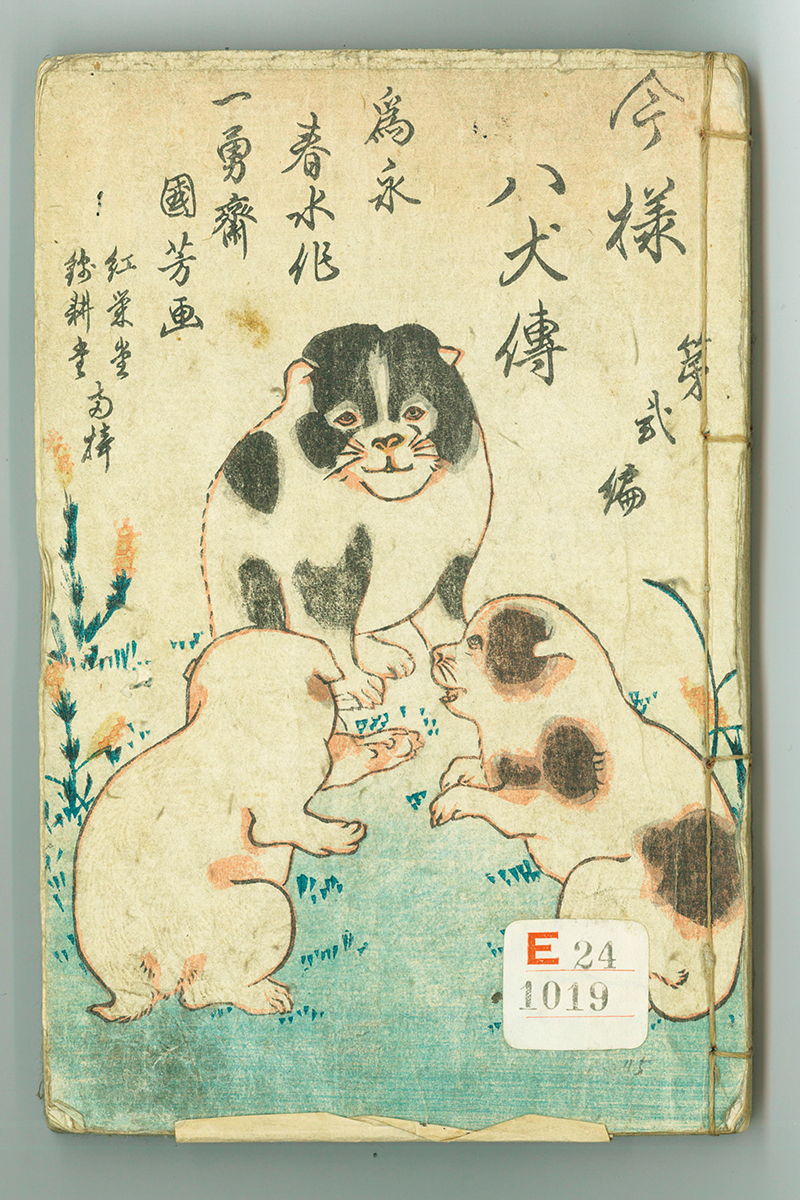
2. Volume 2 of Imayo Hakkenden (“The Modern Eight Dog Chronicles”)
Created by Nisei Tamenaga Shunsui, illustrated by Ichiyusai Kuniyoshi (Seishu Bunko)Following the blockbuster hit kyogen play Satomi Hakkenden, Imayo Hakkenden was published as a series of six picture books. On the front cover of the second book, you can see three spotted dogs painted by Kuniyoshi, a famous painter of cats. -

3. Setsubai Houdan Inu no Soshi (“Book of Dogs”) (Second book)
Created by Ryutei Senka, illustrated by Ichiyosai Toyokuni (Seishu Bunko)A tubby dog that looks like it is wearing a “cooling” ring on its neck is depicted on the cover of the second book of Inu no Soshi, which is a collection of excerpts from Satomi Hakkenden. -

4. Dobutsu Kunmo Shohen Honyurui (“Animal Encyclopedia Volume 1: Mammals”)
Illustrated by Nakajima Gyozan and held by the Museum (Tanaka Yoshio Collection)The character “Yoshio Satonaka,” played by Seiko Ito in NHK’s TV drama Ranman, was created based on the true story of naturalist Yoshio Tanaka. This great man engaged in the organization of exhibitions and founding of museums and zoos as well as in the publication of an illustrated encyclopedia of animals. The encyclopedia has an entry on “Chin” dogs, following the introduction of ordinary dogs, and describes them as cat-sized pets to be kept indoors. -

5. Kenku Yochikuden (“How to Raise a Dog”)
(Created by Akatsuki Kanenaru, Tanaka Yoshio Collection)This is the only existing “how to raise a dog” book from the latter half of the Edo period (1603-1868). It was written by a writer and painter living in Osaka. The writer’s great fondness for dogs is clearly evident in the front cover, illustrations and indeed every sentence. -
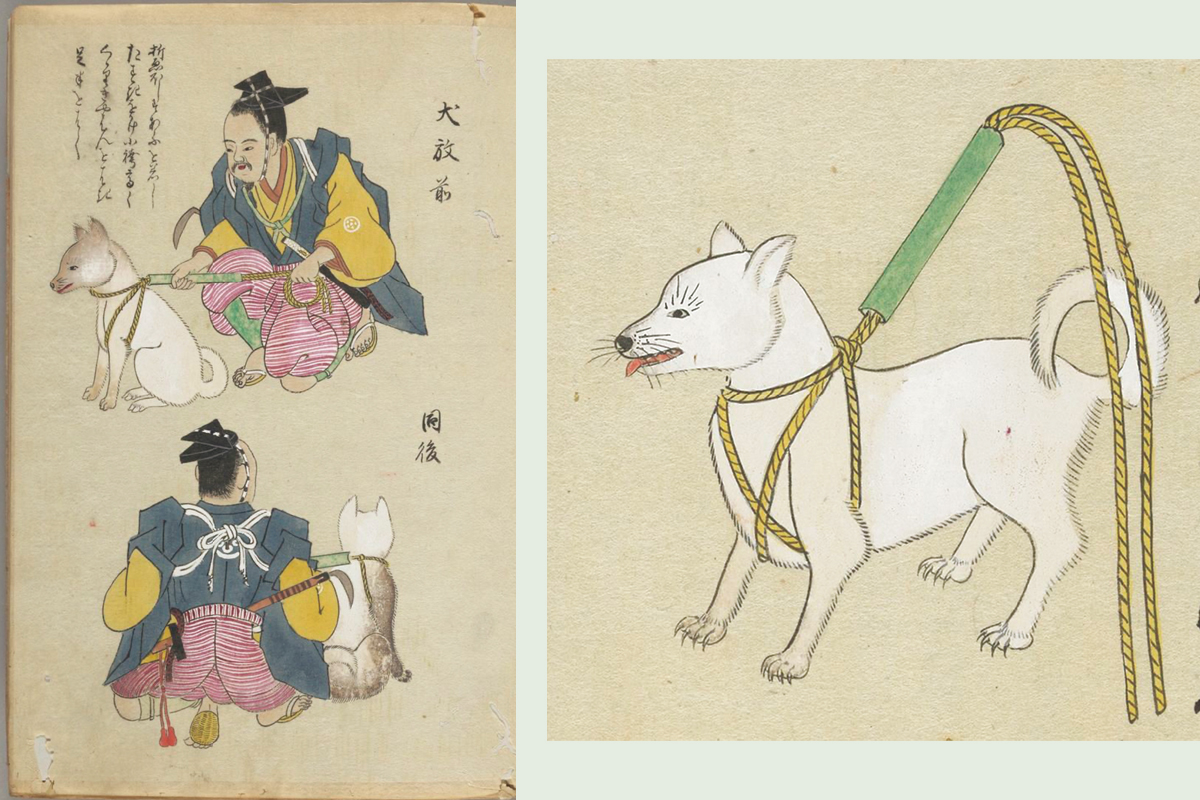
6. Inuoumono Zusetsu (“Diagram of the Inuoumono Sport”)
Created by Ise Sadatake (Nanki Bunko)The sport of hunting dogs with bows from horseback was a required activity for samurais. In a manual on the sport written by a shogunate retainer, dogs are depicted with pitiful expressions (perhaps because they know their fate).
Dogs in the Library of Economics Engravings by William Hogarth (Okochi Collection)Using a self-portrait with a dog to satirize a rival
The Library of Economics owns works of William Hogarth collected by two economists, former UTokyo President Kazuo Okochi and former dean of the Faculty of Economics Akio Okochi. Hogarth is one of the most renowned British painters of the 18th century. Famous for his love of pugs, he depicted his pug “Trump” in several works, including his self-portrait.
-

Painter and his Pug (1801)Painter and his Pug is an engraving based on Hogarth’s 1745 self-portrait, which was an oil painting. According to the explanation given by Professor Kazuyoshi Oishi of the Graduate School of Arts and Sciences at the special exhibition of the Library of Economics’ Hogarth collection held at the Komaba Museum in 2023, Hogarth’s pug represents the painter’s own “pugnacious” character.
-

The Bruiser (1763)The artist also created The Bruiser as caricature of the satirist and clergyman Charles Churchill, who had lampooned Hogarth. Hogarth depicted Churchill as a bear cradling a pot of beer in its right paw and a club inscribed with “lyes” (meaning “lies”) in its left. In the caricature, a pug is urinating on Churchill’s Epistle to Hogarth, and Hogarth can be seen whipping a different bear.
UTokyo’s KomainuKomainu statues watching over UTokyo’s research activities
Komainu (lion-dog) statues are often found at shrines. UTokyo also has some komainu statues.
-

Komainu of the Institute for Advanced Studies on AsiaA well-known pair of komainu statues on campus is placed at the entrance to the Institute for Advanced Studies on Asia (IASA). According to Emeritus Professor Yasushi Oki, who knows a lot about the history of the Institute, the statues used to be at the entrance to the former Institute for Oriental Culture located in the Otsuka neighborhood of Tokyo. That institute had purchased the statues as historical materials in 1932. The Institute then merged with the IASA in 1948, and the building was subsequently used as a facility of the Ministry of Foreign Affairs before being sold to Takushoku University in 1994, when the komainu statues were transferred to the IASA. “The pedestals and the patterns on the back imply that the statues are prestigious examples,” says Emeritus Professor Oki. “Statues as good as these are hard to find, even in China.”
-
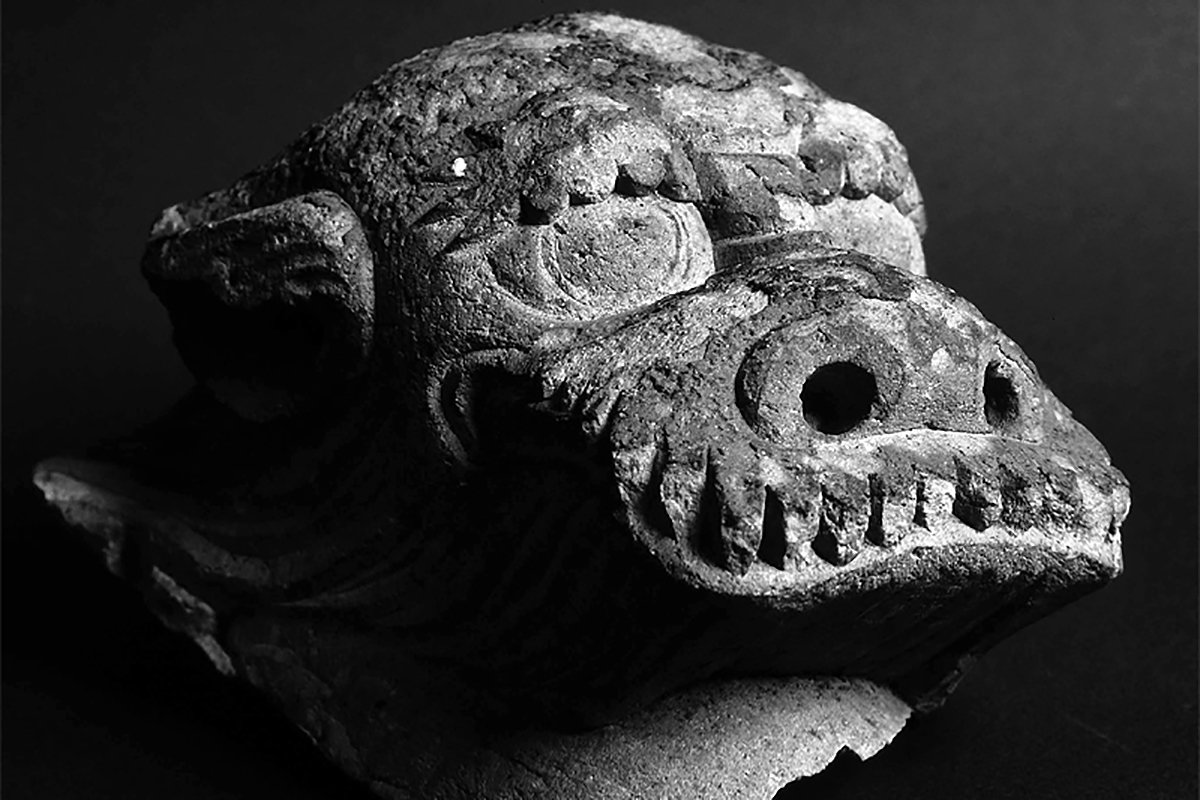
Komainu statues belonging to the University MuseumStored in the University Museum is the head of a komainu statue that has been exposed to nuclear radiation. It was brought to the University in 1945 by a survey group led by then-Professor Takeo Watanabe. Although it was originally thought to have come from Hiroshima Gokoku Shrine in Hiroshima Prefecture, when then-Professor Tokuhei Tagai conducted a detailed survey in 2002, he concluded it very likely that the head had been a pillar ornament of Urakami Cathedral in Nagasaki Prefecture. It is thus an important artifact of human history.
-
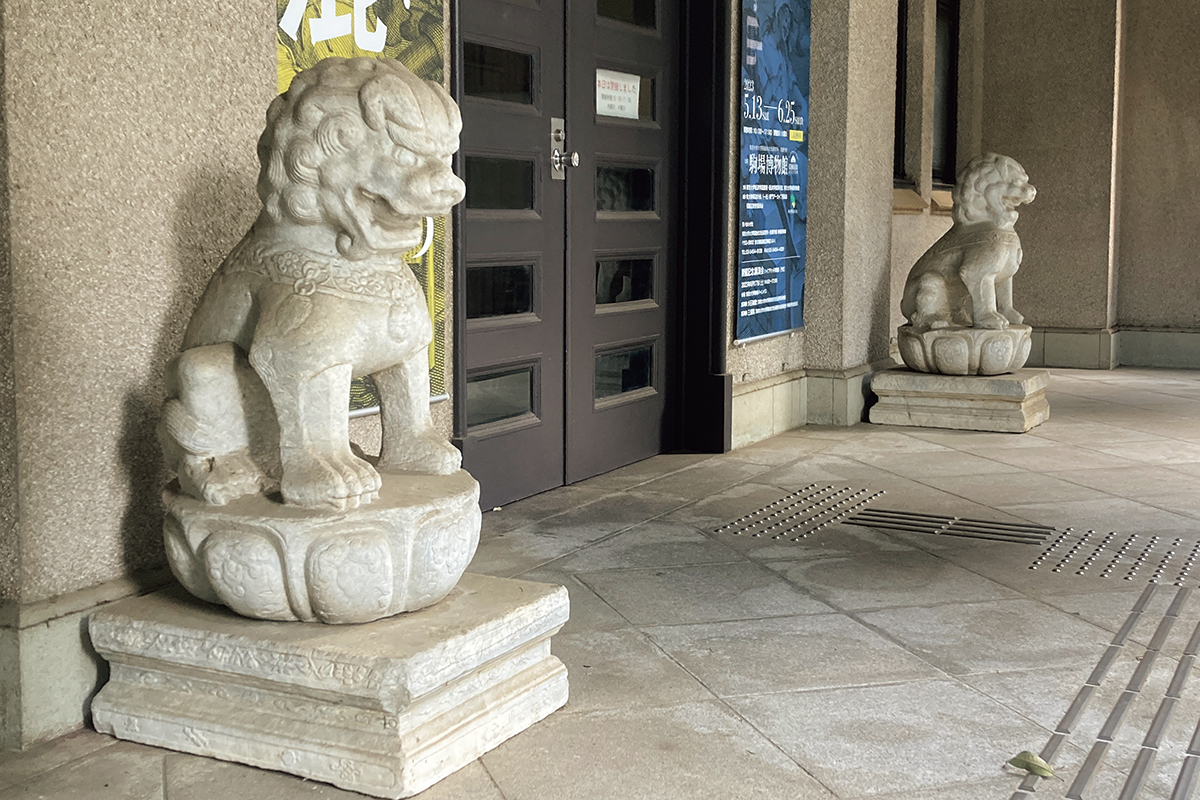
Komainu of the Komaba MuseumAt the entrance of the Komaba Museum, a pair of komainu statues welcome visitors.
Dogs of the Meiji Shinbun Zasshi BunkoDog nursing a cat; dog biting a robber
The Faculty of Law’s Meiji Shinbun Zasshi Bunko is a library with a huge collection of newspapers from the Meiji period (1868-1912), including a range of popular prints called “nishikie shinbun,” which were one-sheet newspapers composed of nishikie (woodblock prints) and news text.
-
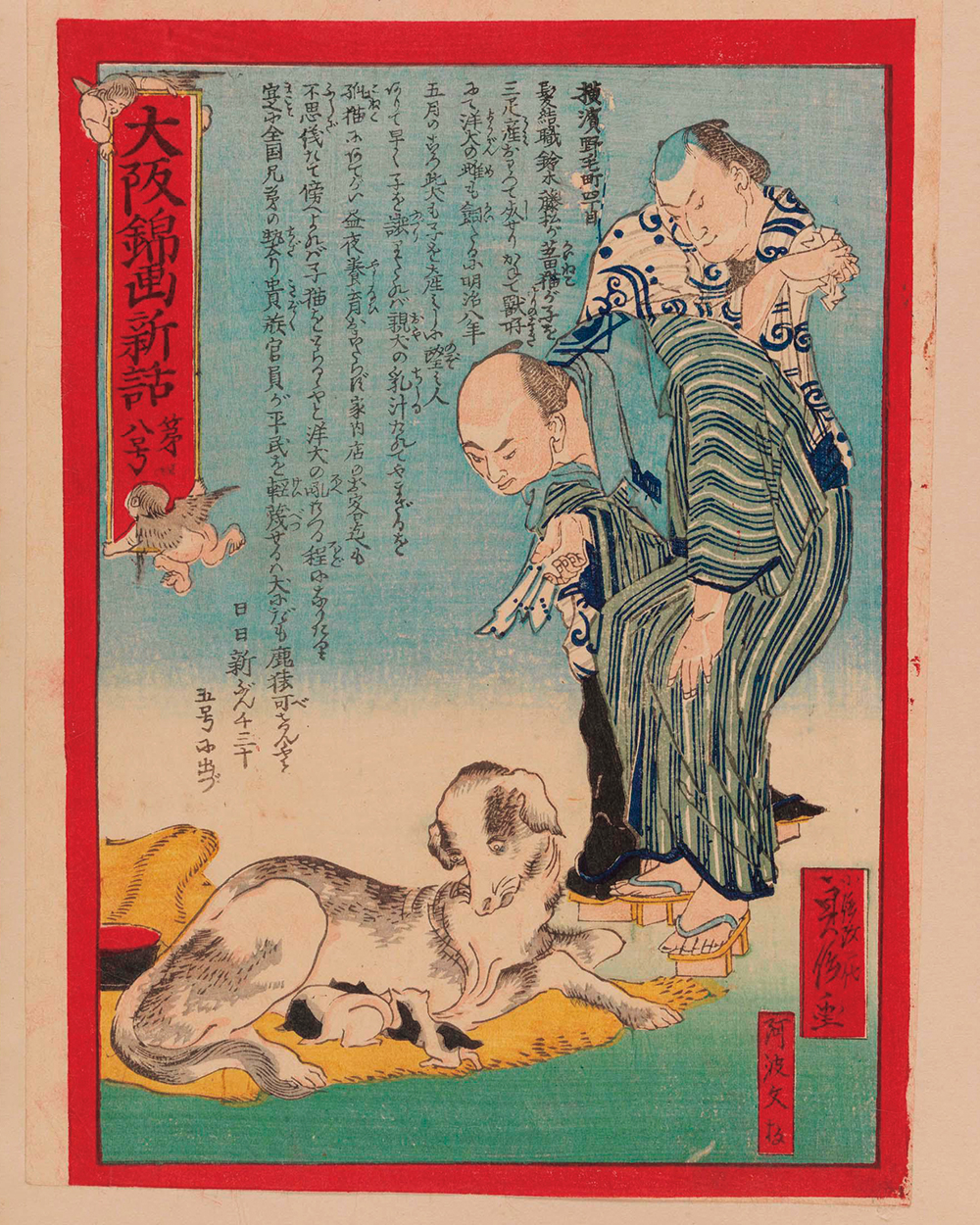
Osaka Nishikie Shinwa No. 8Nishikie shinbun often shared stories of incidents that had happened in the lives of ordinary people. For example, a nishikie shinbun published in Osaka reported on a hairdresser’s dog that had been nursing kittens that had lost their mother.
-

Tokyo Kakusha Senbatsu ShinbunThis nishikie shinbun published in Tokyo carried a story about a dog biting a robber who had broken into the house of a Westerner’s mistress. It is clear from such reports that dogs were kept by ordinary people during the Meiji period.
Dogs of the Archaeological Research UnitWere they used as charms for safe childbirth?
A range of relics have been unearthed at the Hongo Campus, which was formerly a daimyo estate. Some of the unearthed figurines in the collection of the Archaeological Research Unit include those shaped like dogs.
-
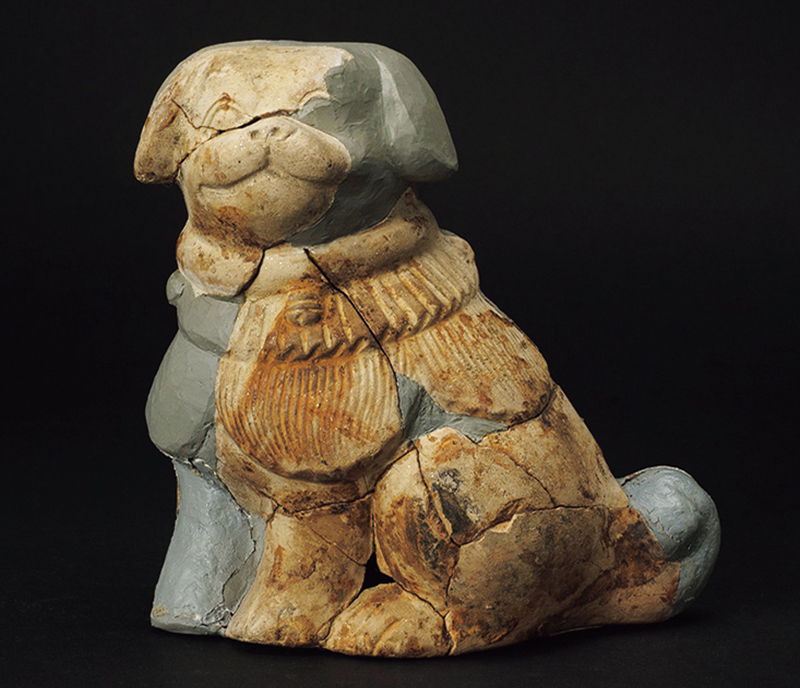
Dog figurine unearthed at the Hongo CampusThis clay figure is a seated Chin statue unearthed at the current location of Gotenshita Memorial Arena (remains site No. 49). This is the same site where a feeding bowl for birds inscribed with the kanji character “纏,” the mark of Maeda Yoshiyasu, last daimyo of the Kaga Domain, as well as a cup from the Saiko (revival) Kutani Minzan kiln and others were found. Such a large dog figure has never been unearthed at the site of an ordinary household, making it one of a number of relics that is unique to the site of the former estate.
-
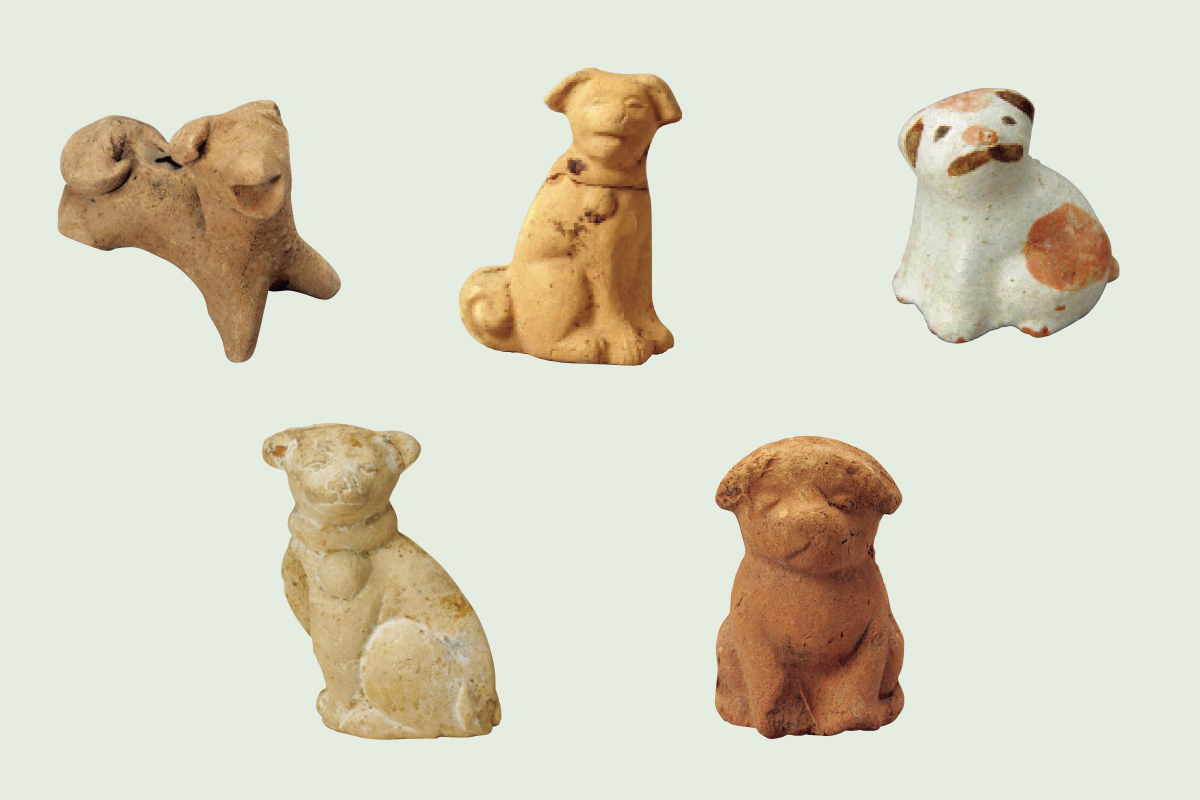
Dog figurines unearthed at the Hongo CampusOther clay dog figures were unearthed at the current location of the Faculty of Engineering Building 14, which is the former site of the sakitegumi (frontline samurai) residence located outside the Kaga Domain. Dogs have long been known for their easy birth, and many dog figurines seem to have been made as lucky charms to ensure a safe delivery, rather than as toys.
Dog in the office of the dean of the Faculty of AgricultureOne of only five stuffed Japanese wolves in the world
Japanese wolves used to live in the Honshu, Shikoku and Kyushu islands of Japan but are said to have become extinct by the beginning of the 20th century. A stuffed example of the species (female wolf from Iwate Prefecture) sits in the office of the dean of the Faculty of Agriculture at the Yayoi Campus. Purchased in 1881 to be stored in the Faculty’s specimen room as part of the collection of the Laboratory of Forest Zoology, it is one of only five stuffed Japanese wolves existing in the world, with the other four held by the British Museum in the U.K., the Naturalis Biodiversity Center in Leiden, the Netherlands, the National Museum of Nature and Science in Tokyo, and Wakayama University (Wakayama Prefecture, Japan).
-

Stuffed Japanese wolf
-

Stuffed Japanese wolf
Dog mascot of the Institute for Solid State PhysicsWhite dog that looks like kashiwamochi
The Institute for Solid State Physics (ISSP) in Kashiwa, Chiba Prefecture has a mascot named “Busseiken.” This dog character was created by senior researcher Naoka Nagamura of the National Institute for Materials Science when she was conducting research at ISSP. Bearing a clear resemblance to a piece of kashiwamochi, a wagashi (Japanese confection) that is served wrapped in an oak leaf, the mascot has been used to publicize the ISSP’s activities since 2013.
-

You can see Busseiken behind ISSP Director Zenji Hiroi, who was photographed here giving his inauguration speech.
-

Decorative strap with a Busseiken stuffed toyThese straps were released for sale in 2018 and completely sold out. They were available to buy once more (at the unit price of 980 yen including tax) at the UTokyo CO-OP at the Kashiwa and Hongo campuses starting from October 27, 2023, which was during Kashiwa Campus’s Open Campus event.
Other topics involving dogs, part 1
-
Dog of the UTokyo Athletic FoundationAkita inu mascot, a successor to Hachiko
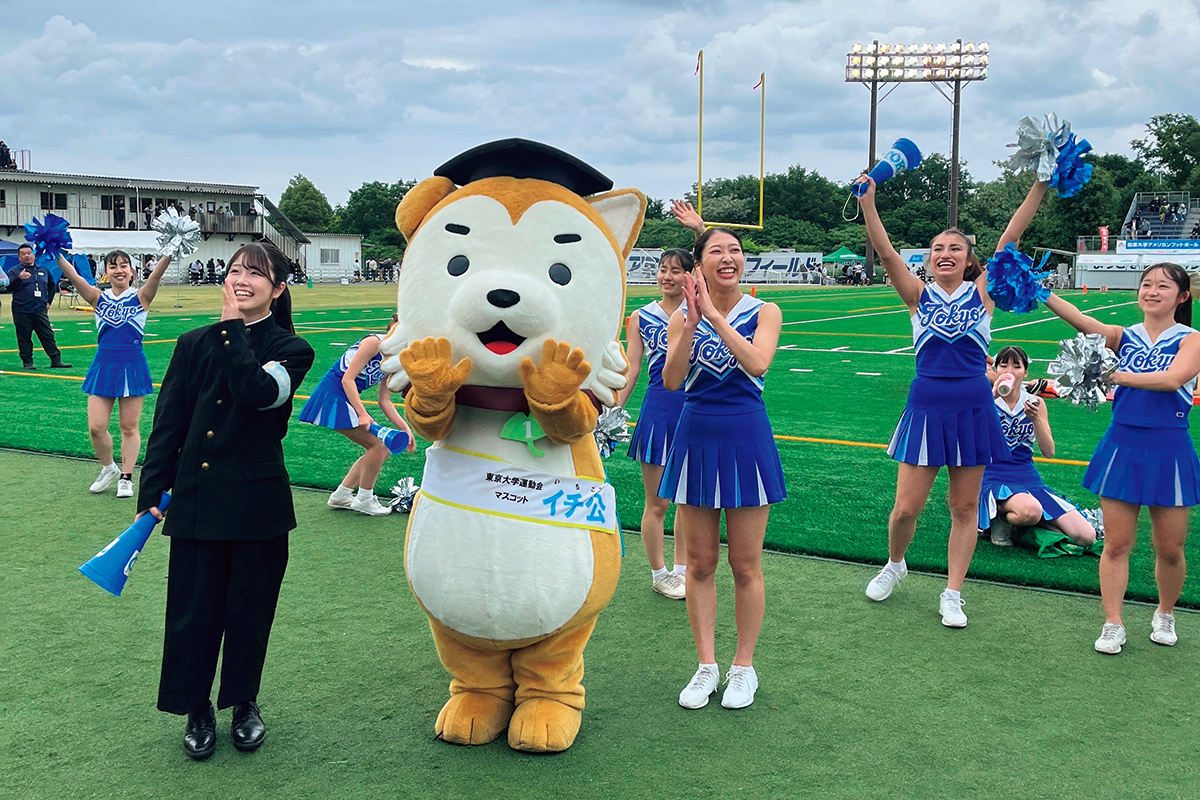
IchikoThis dog mascot character first appeared at the 48th Seven Universities Athletic Meet (7-Univ.) held in 2009 and has since been used as the official mascot of the UTokyo Athletic Foundation. The mascot was named “Ichiko” after Kyusei Ichiko (First Higher School), one of the predecessor institutions of UTokyo. The dog attends classes diligently during the week, and on weekends dedicates himself to cheering on members of the Athletic Foundation clubs. His dream is to go overseas to cheer on club members participating in world competitions. The dog is fond of yakitori (sauce-flavored). The 62nd Seven Universities Athletic Meet ended on September 16, 2023, and UTokyo took the championship!
-
Dog of the University of Tokyo HospitalA Hokkaido inu that comforted patients

NeneThere was once a famous dog in the UTokyo Hospital. The owner of a flower shop named “Flower Canvas” located in the Administration and Research Building of the University of Tokyo Hospital brought their Hokkaido inu dog to work with them. This dog, called Nene, started coming to the shop with her Hokkaido-native master in January 1994, and the dog soon took on the role of welcoming patients. In 2006, which was the year of the dog, Nene was featured on the front cover of the Hospital’s January newsletter with her four puppies. According to the details published at the time, Nene had delivered as many as 13 puppies in total.
-
Dog of the dean of the College of Arts and SciencesThe standard poodle at the Komaba Campus
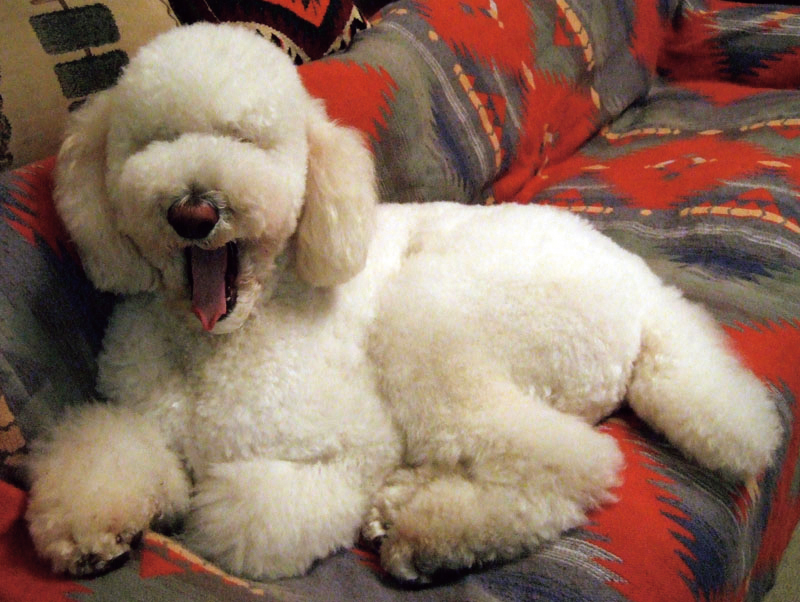
KikumaruEmeritus Professor Toshikazu Hasegawa, former dean of the Graduate School of Arts and Sciences and the College of Arts and Sciences, is a dog lover. His dog Kikumaru appeared in a press release published in 2013, in which the professor revealed that yawns by a dog’s master were more contagious for them than those from a stranger. Kikumaru had also appeared in a TV program titled Bura Tamori. “Kikumaru went to the dean’s office with me every day and crossed the Rainbow Bridge just before his 15th birthday. I am now happily living with Maggie (three years old) and Kogiku (eight years old) from the same pedigree as Kikumaru,” says Emeritus Professor Hasegawa. He writes about his happy life with dogs at kikulog2.xsrv.jp.
-
Materials on dogs stored in the University of Tokyo ArchivesRemoving strays from campus due to rumors of rabid dogs

Catching stray dogs on campusThe University of Tokyo Archives, which is tasked with keeping and managing the use of corporate documents and materials about UTokyo’s history, stores a large quantity of interdepartmental administrative documents. In one such document distributed to general affairs staff by the Student Support Office (predecessor of the current Student Support Group) on June 2, 1926, it says that the University would round up stray dogs found on campus in cooperation with the local police department on June 6. Although this is not the case today, it seems that back then, dogs that could cause harm to members of the UTokyo community roamed around campus.
-
Legend about dogs and the Komaba DormitoryWas it natural to eat dogs?
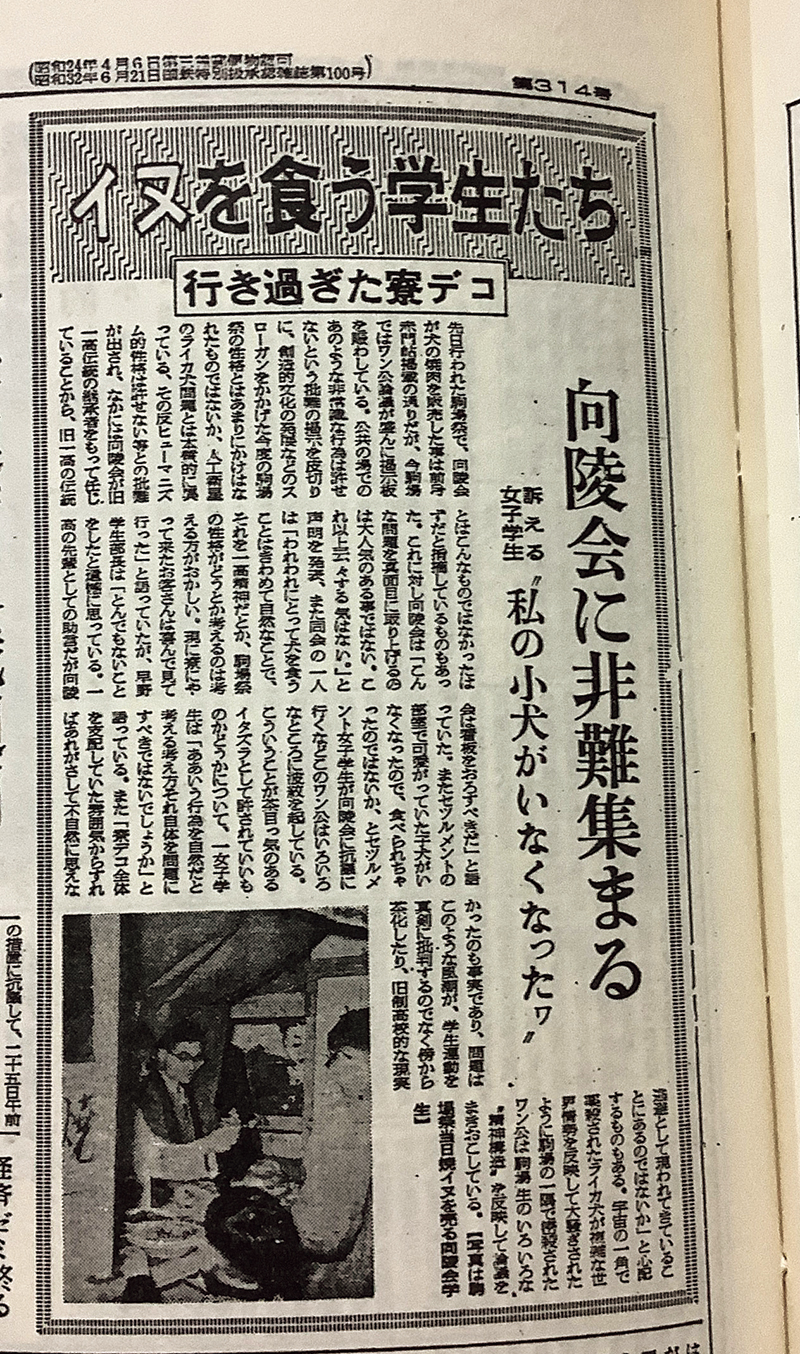
November 27, 1957 edition of The University of Tokyo NewspaperIn some old printed documents about the University, you can find materials alleging that some students of the Komaba Dormitory used to eat dogs. For example, a University of Tokyo Newspaper article from 1957 contains a photo showing “yakiinu” pieces of dog meat, rather than “yakitori” pieces of chicken being sold at the Komaba Festival, alongside a comment from a student who said, “To us, eating dogs is extremely natural.” Also, in a book titled Zokuzoku Mutsugoro no Hakubutushi (“More of Mutsugoro’s Natural History”; published by The Mainichi Newspapers in 1976), author Masanori Hata, who passed away this April (2023), wrote that he and his colleagues once decided they would eat a stray dog that was hanging around the dormitory before it could be taken away by public health officials. They were too late, however, finding that students from the karate club had already eaten it. This is a story from only 60 years ago.
-
Dog of UTokyo’s TwitterHachiko also enjoys great popularity in a tweet series
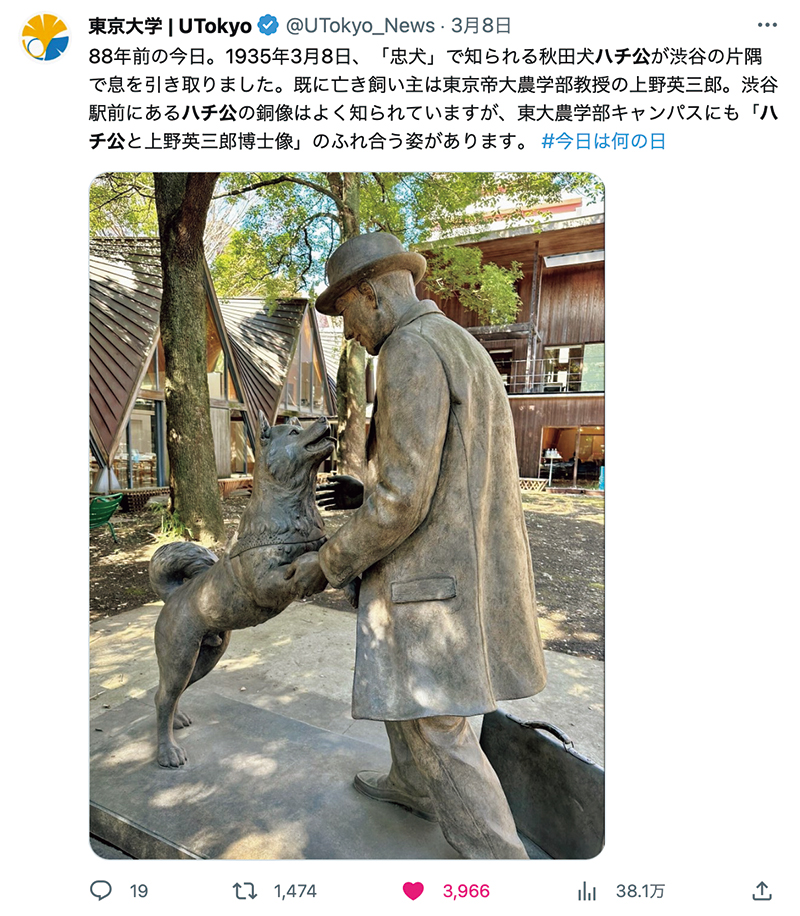
“On this day” tweet, March 8, 2023UTokyo’s official Japanese Twitter account started an “on this day” series, in which UTokyo-related events that happened on a specific day are introduced with images, in December 2021. The series has been receiving a lot of engagement, but the tweets dated March 8, the anniversary of Hachiko’s death, have proven particularly popular, both in 2022 and 2023. The Hachiko tweet in 2023 gained as many as 1483 “likes,” 3,987 retweets and 381,000 impressions (as of July 31, 2023). What will happen following the renaming of Twitter to X?
Other topics involving dogs, part 2
In the following, we introduce as many dog-related research activities that we could not fit into the special feature as possible:
- Associate Professor Tomohiro Yonezawa and others at the Graduate School of Agricultural and Life Sciences announced in a press release dated August 2, 2023 that administering large doses of docosahexaenoic acid (DHA) to dogs with idiopathic epilepsy helps reduce the frequency of seizures.
- Professor Shigeo Fujiwara at the Historiographical Institute made a report about the dog hunting ground depicted on a folding screen titled Rekiden Kohon Rakuchu Rakugai Zu Byobu at a meeting of a study group on Japan’s medieval history held as part of the Annual Meeting of the Historical Society of Japan organized in November 2021.
- Associate Professor Toshihiro Fujioka at the Graduate School of Arts and Sciences held a webinar (second Global Studies Seminar) with a focus on Emmanuel Levinas’s essay titled The Name of a Dog, or Natural Rights (1975) on September 26, 2022.
- In November 2019, Professor Hideki Endo at the University Museum and Professor Hisashi Inokuma at the Veterinary Medical Center, Graduate School of Agricultural and Life Sciences published the second edition of Inu no Dobutsugaku (“The Zoology of Dogs”; The University of Tokyo Press), which focuses on the close partnerships people have developed with dogs.
- In the UTokyo Chiba Forest database of vascular plant specimen images, there are numerous images of plants with names that start with the word “inu” (meaning “dog”), such as inutsuge, inugoma, inuhoozuki, inubiwa, inuhagi, inumugi, inumaki, inuwarabi and inushida. It seems that the prefix “inu” is often used for plants that are not useful to human beings.
- The Electron Microscope Section of the Institute for Solid State Physics shares photos of dachshund hair and ooinufuguri (Persian speedwell) pollens taken using a scanning electron microscope (SEM) on the “SEM Shashinkan” webpage.







